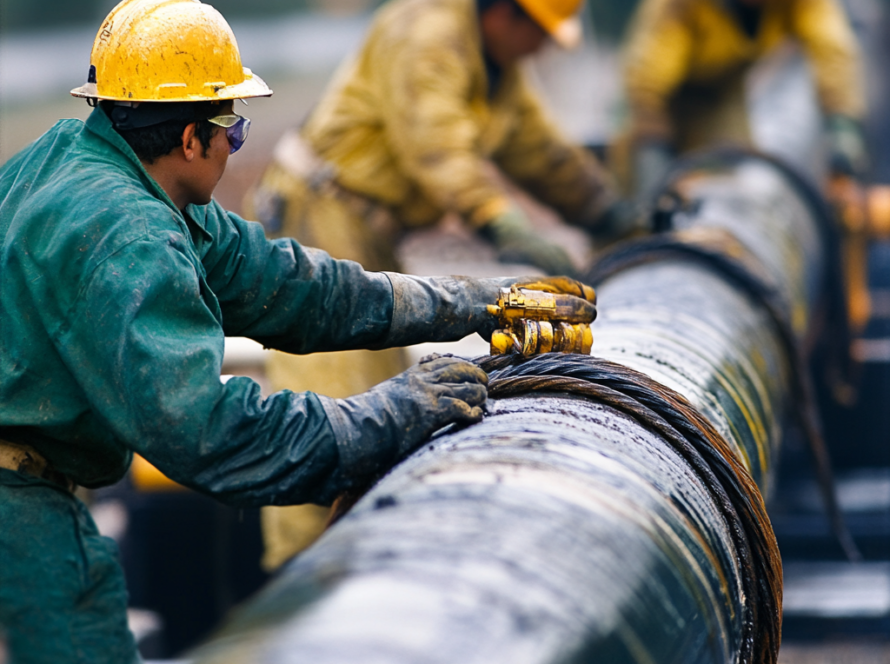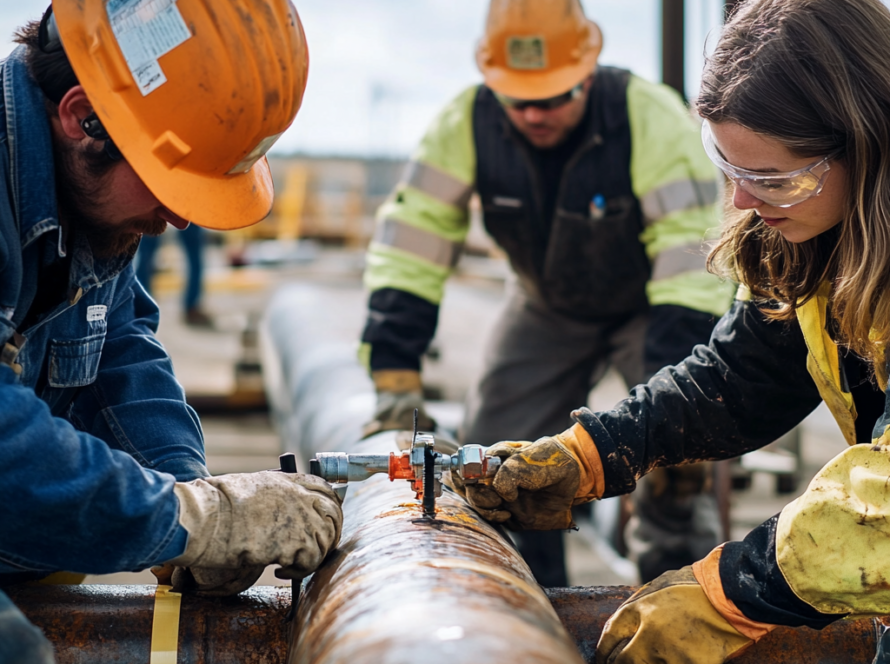In today’s fast-paced industrial landscape, maintaining the integrity of equipment and infrastructure is more critical than ever. Corrosion, often referred to as the “silent destroyer,” can lead to the degradation of valuable assets, resulting in significant operational downtime, costly repairs, and even safety risks. With the advent of data-driven corrosion monitoring, however, companies can now proactively manage corrosion, optimize maintenance strategies, and enhance overall operational efficiency.
Data-driven corrosion monitoring is revolutionizing industries such as oil & gas, chemical processing, water treatment, and power generation. By continuously collecting and analyzing real-time data on corrosion rates, companies can make informed decisions that prevent asset failure and maximize the lifespan of critical infrastructure. In this blog post, we will explore how data-driven corrosion monitoring optimizes maintenance strategies, leading to better asset management, reduced costs, and improved safety.
Understanding Data-Driven Corrosion Monitoring
Traditional corrosion monitoring methods, such as periodic inspections and corrosion coupons, provide valuable insights but are often reactive in nature. These techniques only deliver data after corrosion has occurred, limiting the ability to take preventive measures in real-time. Data-driven corrosion monitoring, on the other hand, involves the use of advanced sensors, data collection systems, and real-time analytics to continuously track corrosion activity and predict potential failures before they happen.
Key technologies in data-driven corrosion monitoring include:
- Electrochemical sensors that measure real-time corrosion rates.
- Ultrasonic testing for detecting metal loss and wall thinning in pipelines and vessels.
- Remote monitoring systems that transmit corrosion data from sensors in hazardous or hard-to-reach locations to centralized data hubs.
- Data analytics platforms that analyze corrosion data trends and provide actionable insights.
By leveraging these technologies, companies can move from reactive maintenance strategies to proactive and predictive approaches, enhancing overall asset management.
The Benefits of Data-Driven Corrosion Monitoring
- Proactive Maintenance
One of the primary benefits of data-driven corrosion monitoring is the ability to implement proactive maintenance strategies. Instead of waiting for equipment to fail or for visible signs of corrosion to appear, continuous data collection enables asset managers to identify corrosion activity in its early stages. This allows maintenance teams to address issues before they escalate, preventing costly repairs and minimizing unplanned downtime.
For example, in an oil refinery, real-time corrosion data from pipelines and storage tanks can reveal increasing corrosion rates long before they cause leaks or structural damage. Maintenance can then be scheduled during planned downtime, preventing an unexpected shutdown that could cost millions of dollars.
- Optimized Maintenance Schedules
Data-driven corrosion monitoring not only allows for proactive intervention but also enables companies to optimize their maintenance schedules. Instead of relying on fixed, time-based inspection intervals, data analytics can provide insights into when and where maintenance is truly needed. This leads to more efficient use of resources, as maintenance is only performed when required based on actual corrosion data rather than arbitrary timelines.
For example, if corrosion monitoring data reveals that certain sections of a pipeline are experiencing higher corrosion rates due to environmental factors (e.g., exposure to moisture or chemicals), maintenance can be prioritized in those areas. Conversely, sections with minimal corrosion can have their maintenance deferred, reducing unnecessary costs.
- Predictive Maintenance
Predictive maintenance takes proactive strategies a step further by using data analytics and machine learning to forecast when corrosion-related failures are likely to occur. By analyzing historical corrosion data alongside environmental conditions, operating parameters, and material properties, predictive models can be developed to estimate the remaining useful life of assets. This allows maintenance teams to replace or repair components just before they fail, minimizing disruption and extending asset life.
For instance, in the power generation industry, corrosion monitoring data from steam turbines and boilers can be used to predict when metal fatigue or corrosion cracking might occur. By scheduling maintenance based on these predictions, companies can prevent equipment breakdowns and avoid the high costs associated with emergency repairs.
- Targeted Inspections
Data-driven corrosion monitoring helps prioritize inspections and maintenance efforts, allowing companies to focus on high-risk areas rather than conducting blanket inspections across entire facilities. This targeted approach saves time and resources while ensuring that critical assets receive the attention they need.
In the chemical processing industry, for example, corrosion monitoring sensors placed in pipelines that carry corrosive chemicals can highlight specific areas where corrosion rates are higher. Inspection teams can then focus their efforts on those pipelines rather than conducting broad inspections, improving efficiency and reducing inspection costs.
- Reduced Downtime
One of the most significant advantages of data-driven corrosion monitoring is the reduction in unplanned downtime. Equipment failure due to corrosion is one of the leading causes of unexpected downtime in industries like oil & gas and chemical processing. By continuously monitoring corrosion activity and taking preventive measures, companies can avoid costly shutdowns and keep their operations running smoothly.
For example, in offshore oil platforms, where downtime can cost hundreds of thousands of dollars per day, real-time corrosion monitoring of critical assets like pipelines, valves, and storage tanks ensures that potential issues are identified and addressed before they disrupt production.
- Increased Asset Longevity
Corrosion is a leading cause of asset degradation, leading to shorter lifespans for equipment, structures, and infrastructure. Data-driven corrosion monitoring helps extend asset life by allowing for timely interventions and the implementation of protective measures such as coatings, cathodic protection, or material upgrades.
In water treatment plants, for instance, monitoring the corrosion rates of water pipes and storage tanks can prevent metal loss and contamination, extending the useful life of the equipment. By investing in data-driven monitoring, companies can significantly reduce the need for premature asset replacement and lower their overall capital expenditures.
- Enhanced Safety and Regulatory Compliance
Safety is paramount in industries where corrosion can lead to hazardous conditions, such as oil spills, toxic leaks, or equipment failures. Data-driven corrosion monitoring helps maintain the structural integrity of assets, ensuring that safety standards are met. Real-time data allows operators to detect and mitigate potential safety hazards before they escalate into accidents.
Furthermore, regulatory bodies such as the Occupational Safety and Health Administration (OSHA) and the Environmental Protection Agency (EPA) mandate strict asset integrity and maintenance protocols in many industries. Data-driven monitoring provides companies with the data they need to demonstrate compliance with safety and environmental regulations, avoiding costly fines and legal penalties.
Real-World Applications of Data-Driven Corrosion Monitoring
Data-driven corrosion monitoring is already making a significant impact in various industries:
- Oil & Gas: Offshore platforms and pipelines are continuously monitored using electrochemical sensors and remote monitoring systems. These systems provide real-time data to onshore control centers, enabling operators to detect corrosion hotspots and prioritize maintenance.
- Chemical Processing: Corrosive chemicals often cause rapid metal loss in pipes and tanks. Data-driven monitoring allows for the early detection of corrosion, minimizing the risk of leaks and contamination.
- Water Treatment: Data-driven monitoring of water distribution networks and storage tanks helps ensure the integrity of water infrastructure, preventing corrosion-related contamination and maintaining the quality of the water supply.
- Power Generation: Boilers, steam turbines, and cooling towers are subject to corrosion due to high temperatures and exposure to water and chemicals. Real-time monitoring systems provide valuable insights that help prevent costly equipment failures.
Conclusion
Data-driven corrosion monitoring is transforming how industries manage and maintain their assets. By leveraging real-time data and advanced analytics, companies can optimize their maintenance strategies, reduce downtime, and extend the lifespan of critical equipment. From proactive maintenance and targeted inspections to predictive maintenance and enhanced safety, the benefits of data-driven corrosion monitoring are clear.
As industries continue to embrace digital transformation, the integration of data-driven technologies into maintenance practices will become even more essential. Investing in data-driven corrosion monitoring not only protects valuable assets but also ensures operational efficiency, safety, and long-term sustainability.




